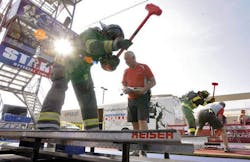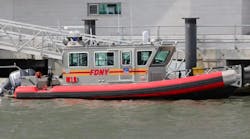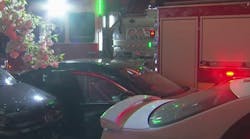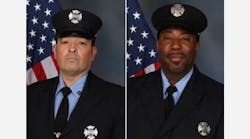Recently I had a pinnacle event occur in my career. I was participating in the Job Related Physical Abilities Test at work. I found myself after running this test saying what the heck just happened? A friend of mine was on duty and assisting with the testing. He asked me after i completed the exam if I was OK? The conversation continued with me asking how do I look? His reply was, "Like you crap." I replied, "I feel like it as well, I may be a statistic." there was some humor in this but reality was, I was spent. What used to be easy was now challenging. I guess reality set in about being not so diligent on hitting the weight room or doing cardiovascular training. Reflecting on my increasing age came to mind. Bottom line is the job of firefighting requires certain abilities and physical conditioning levels. This article will explore the etiology behind why we need to make this a priority in our organizations and personal lives.
In 2009 the fire service saw just under 100 line of duty deaths. Nearly 50 percent of these deaths were related to heart attacks. For more than 20 years, the leading cause of line of duty deaths in the fire service has been attributed to “heart attacks”. The majority of line of duty deaths due to heart attacks occurs suddenly and with few or no warning signs. In 1998 the U.S. Fire Administration’s data shows that 41 firefighters died of heart attacks or strokes, 19 of which had prior histories of cardiac or vascular disease. Training exercises accounted for 12 line of duty deaths, with 8 of these being from heart attacks.
There are several standards and rules that address physical conditioning;
Ø 29CFR 1910.120
Ø 29CFR 1910.134
Ø NFPA 1500 Chapter 8, 8-1
Ø NFPA 1500 Chapter 8, 8-3
Ø NFPA 1582 Standard on Medical Requirements for Firefighters
So with all of these standards and rules why is the number of deaths due to heart attacks so high?
Anatomical FactorsNinety percent of the cases of firefighters who have died suddenly, the anatomic abnormality present is coronary artery atherosclerosis. Some of the hearts had scarring from previous myocardial Infarctions (MI) or heart attacks.
Transient FactorsThe second element in sudden cardiac death is some sort of transient event that perturbs normal cardiac physiological. When emergency scene operations are taking place, the transient event is assumed to be some effect of exertion. Five years of studies have shown that there is a 5-times greater risk of a myocardial infarction within the hour after heavy exertion than during times of sedentary life activities. Other studies have shown a documented increase of sudden deaths or MIs following natural disasters and in the early morning hours, both situations are when stress is heightened. To those of us involved in the fire service, it is obvious that fire fighting related sudden deaths is too frequent given the small amount of time that is spent in a tour of duty directly engaged in emergency scene operations. Therefore, some effect of emergency scene operations must factor into these deaths. These factors are exertion and stress levels.
Electrophysiological FactorsThe third event associated with most sudden cardiac deaths is an electrophysiological abnormality that triggers an arrhythmia (rhythm disturbance). These occur because of abnormalities in transport of ions across cell membranes, which is the way electrophysiologic impulses are propagated. These abnormalities can occur in normal heart muscle that is damaged by a medication or electrolyte imbalance. Electrolyte imbalance is probable for most firefighters after each working incident due to the amount of body fluid lost due to the heat factor of gear. It is not uncommon for firefighters who are engaged in heavy workloads during fire suppression activities to loose consistently a liter of fluid in approximately 20 minute. This is a significant amount that can cause severe electrolyte imbalances if the firefighter is not properly hydrated prior to the incident (most of which are not).
So how do we reduce these line-of-duty deaths? “Sudden cardiac death in the fire service is almost always a manifestation of coronary heart disease. Therefore, fire service instructors and safety officers should incorporate heart disease prevention strategies into the training program of every fire department. There should be special effort to identify the highest risk firefighters, the ones with known coronary disease and especially those with prior myocardial infarctions. They should be cleared for active firefighting duty, only after an extensive cardiology evaluation by a cardiologist who understands the nature of firefighting. All firefighters should be evaluated on an annual basis and in compliance with NFPA 1582 and 1583 standards. Even then, it must be realized that screening tests, such as exercise tolerance tests, are only 60 percent likely to disclose coronary disease in a person with no symptoms. Therefore, common sense must dictate the roles played by older firefighters.
Finally, the importance of prevention cannot be overstated. A coronary disease control program must be viewed as an integral part of every fire department safety plan. Exercise and physical fitness are proven beyond doubt to effectively reduce the risk of sudden cardiac death and MI and especially the risk of these events during times of stress and exertion. Similarly, cigarette smoking cessation has been shown to reduce the risk of cardiac death from twice normal to normal after 2 years. Hypertension and cholesterol management schemes also reduce the risk of heart disease in a statistically documented manner.
There is no other training or management issue in the fire service that has been this well documented to reduce firefighter deaths,”Dr. Thomas Griggs, University of North Carolina Hospitals, preformed this study. So what makes this doctor such an expert on what the fire service has experienced? Well I guess when you are a cardiologist you would understand these things and especially when your side line area is a firefighter / instructor.As I look around at attendees of conferences and seminars across the United States, review line of duty deaths and have personally felt the effects of line of duty deaths of two close friends, both from heart attacks it makes you stop and think. YES, the fire service does have a problem with fitness levels. The awareness has increased drastically from ten years ago but we have a long way to go. I know this is blunt, but when I sit with my fellow fire service colleagues and one of the problems I see not only with them but me is…am I in the physical condition I need to be? I bet each of you could look around your departments and point out members who need a little work to a whole lot of work to be in the physical condition they need to be. So what can we do about it? Our budgets don’t allow funding for exercise equipment. I have heard this so many times that it is a canned phrase and just an excuse. It takes little money to make an obstacle course to run for cardiovascular, streets, sidewalks and local school tracks are free to those who wish to run. The problem is we try to hide behind the problems of budgeting. It’s an easy scapegoat. Fact is that’s just what it is…an excuse.
If you have the fancy equipment, more power to you. If you don’t have the fancy equipment go back to the basics. Here are some tips to help:- For endurance and strength for pulling hose with out dragging real hose, get a large truck tire, a twelve-foot piece of hose (preferably with a male coupling for a nozzle); attach the hose to the tire with screws. Then fill the tire with something to make it heavier (concrete works well). Then you drag this new training aid from point A to point B…approximately 50 – 100 feet. I bet you will not get near as tired your next big fire while dragging hose.
- Select a place that will allow you to run or power walk for added cardiovascular endurance.
- A course can be set up utilizing barrels, cones and stations to do calastinics. The calastinics replace weights in strength training.
- Utilize that DVD around the station for exercising. Ty-Bo is an excellent cardiovascular workout. Just a few DVDs can take you from basic to advanced.
Remember the key to being a physically fit firefighter is your own personal choice. The future is in your hands!






